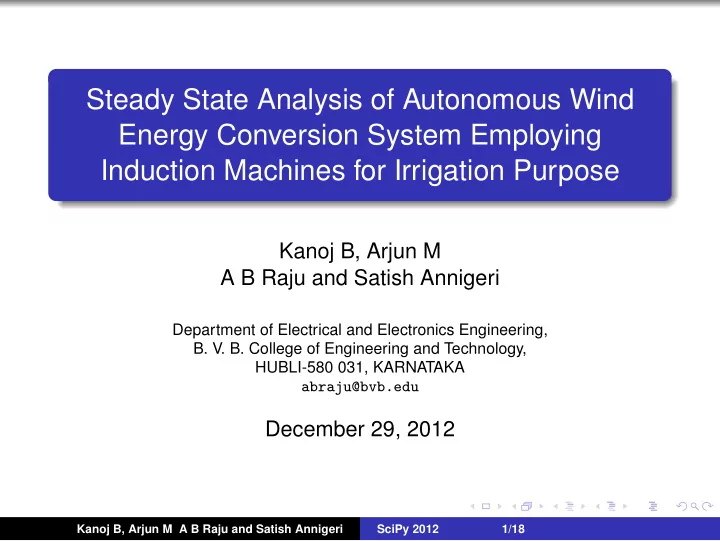

Steady State Analysis of Autonomous Wind Energy Conversion System Employing Induction Machines for Irrigation Purpose Kanoj B, Arjun M A B Raju and Satish Annigeri Department of Electrical and Electronics Engineering, B. V. B. College of Engineering and Technology, HUBLI-580 031, KARNATAKA abraju@bvb.edu December 29, 2012 Kanoj B, Arjun M A B Raju and Satish Annigeri SciPy 2012 1/18
Overview Objective of the Presentation 1 Block Diagram and Flowchart 2 Wind turbine and Induction Machine Specifications 3 Equivalent Circuit 4 Building Mathematical Model 5 Why Python and SciPy? 6 SciPy Code for solving nonlinear algebraic equations 7 Results 8 Conclusion 9 10 References Kanoj B, Arjun M A B Raju and Satish Annigeri SciPy 2012 2/18
Objective of the presentation To use Scientific Python as a computational tool for steady state analysis of wind energy conversion system Kanoj B, Arjun M A B Raju and Satish Annigeri SciPy 2012 3/18
Block diagram and flow chart Kanoj B, Arjun M A B Raju and Satish Annigeri SciPy 2012 4/18
Wind Turbine and Induction Machine Specifications Wind turbine specifications: Swept area radius r = 1.27 m cut-in wind speed v c = 3 m/s rated wind speed v r = 15 m/s furl-on wind speed v f = 25 m/s Induction Machine specifications 3 Phase, 50 Hz, 4 pole, 5 HP , 1450 rpm, 415 V Stator resistance r s = 5.2 Ω Rotor Resistance r r = 4.66 Ω Stator and rotor reactances x s and x r = 2.46 Ω Core resistance r c = 746.40 Ω Kanoj B, Arjun M A B Raju and Satish Annigeri SciPy 2012 5/18
Equivalent Circuit Kanoj B, Arjun M A B Raju and Satish Annigeri SciPy 2012 6/18
Building Mathematical Model Applying Kirchhoff’s voltage law to the loop current I g the resulting equation is I g Z g = 0 Z g = Z 1 + Z 2 + Z 3 Z r Z m Z 1 = Z r + Z m F jX m R m Z m = R m + F jX m Z 2 = R s + F jX s ( R l + F jX l ) jX c Z 3 = R l + F jX l + jX c Kanoj B, Arjun M A B Raju and Satish Annigeri SciPy 2012 7/18
Substituting Z 1 , Z 2 and Z 3 , we get R l − X r X m + jX m R r − FR l + j ( X c − F 2 X l ) + R s − X l X c + jX l F − v F F + jX s + = 0 R r F − v + j ( X r + X m ) Its a complex non-linear algebraic equation and is solved for F and X m by separating real and imaginary parts and equating them to zero separately. Kanoj B, Arjun M A B Raju and Satish Annigeri SciPy 2012 8/18
Solving Non Linear Equations Non linear equations can be solved numerically either writing our own code in compiled languages like: C or C++ 1 Fortran 2 or using the readily available routines in interpreter languages like: MATLAB 1 Scilab and 2 Octave 3 Python 4 Kanoj B, Arjun M A B Raju and Satish Annigeri SciPy 2012 9/18
Why Python and Scipy? Free and open-source software, widely used, with a vibrant community. It has rich modules/libraries. Well thought out language, allowing to write very readable and well structured code. Capability of handling complex numbers and equations. Possibility of improving performance comparable to compiled languages Possibility of developing GUI application. Kanoj B, Arjun M A B Raju and Satish Annigeri SciPy 2012 10/18
Why Python and Scipy? SciPy is an Open Source library of scientific tools for 1 Python. It gathers a variety of high level science and engineering 2 modules together as a single package. Using numpy, scipy and matplotlib modules, one can think 3 of replacing a well known proprietary software. In this presented work, we have used the following routines from scipy.optimize fsolve() newton krylov() and matplotlib.pyplot Kanoj B, Arjun M A B Raju and Satish Annigeri SciPy 2012 11/18
SciPy Code For Solving Non-Linear Equations def funct(x): Xmg = x[1] F = x[0] Zl = (Rl/F) + (1j*Xl) Zc = (-1j*Xc)/(F**2) Zcc = (Zl * Zc ) /(Zl + Zc) Zsg = (Rs/F) + (1j*Xs) Zrg = (Rr/(F-v)) + (1j*Xr) Zmg = ((F/Rc) + (1/(1j* Xmg)))**(-1) Zaa = (Zmg * Zrg)/(Zmg + Zrg) g = Zaa + Zsg + Zcc out = [real(g)] out.append(imag(g)) return array(out) D = fsolve(funct,array([1.0, 1.0])) Kanoj B, Arjun M A B Raju and Satish Annigeri SciPy 2012 12/18
Results Kanoj B, Arjun M A B Raju and Satish Annigeri SciPy 2012 13/18
Results Kanoj B, Arjun M A B Raju and Satish Annigeri SciPy 2012 14/18
Results of Python against Matlab Kanoj B, Arjun M A B Raju and Satish Annigeri SciPy 2012 15/18
Conclusion Python code executes faster than the corresponding Matlab code by a factor of about 7.197474264. Ten iterations of Matlab code using fsolve() took 1.8346 s, whereas Python fsolve() took 0.254894971848 s, and newton krylov() took 1.17562890053 s. newton krylov() function of python executes faster than fsolve() by a factor of 4.612209068 Kanoj B, Arjun M A B Raju and Satish Annigeri SciPy 2012 16/18
L. Shridhar, Bhim Singh, C. S . Jha and B.P . Singh, “Analysis of Self Excited Induction Generator feeding Induction Motor”, Analysis of Self Excited Induction Generator feeding Induction Motor ,pp. p. 390 - 396, June, 1994. Kanoj B, Arjun M A B Raju and Satish Annigeri SciPy 2012 17/18
THANK YOU Kanoj B, Arjun M A B Raju and Satish Annigeri SciPy 2012 18/18
Recommend
More recommend